How NOT to Build a Boat
How NOT to Build a Boat is now available!
For more information, and instructions on how to order, please visit the Yacht Mollymawk website.
 How NOT to Build a Boat is the story of Mollymawk, the Schinas family’s current cruising yacht and their only home.
How NOT to Build a Boat is the story of Mollymawk, the Schinas family’s current cruising yacht and their only home.
The book begins with a question: “Why build, when you could buy a second hand boat for less?” Nick and Jill Schinas had no very great desire to become boat-builders; their great passion is sailing. For seven years they had been merrily bumming around the Atlantic in an old GRP ketch. However, when they reached the Southern Ocean they discovered that their boat was not up to scratch. When she was rolled, by massive waves, her masts were snapped and her hatches were torn off.
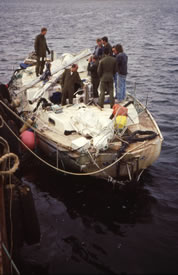
The might of the ocean is quite inconceivable to anyone who has not experienced it. The waves which rolled Maamari - tens of tons of water tumbling inexorably in their cycle - were sufficient to split three-quarter inch teak hatch coamings; sufficient to fracture three-quarter inch marine plywood hatchboards, as if by a karate chop, and sufficient to buckle the aluminium track in which they sat. ... The inner forestay was pulled out, taking with it a triangle of fibreglass-sheathed plywood decking with sides 18 inches long. Thin teak planks glued on top of the fibreglass in imitation of a laid deck were simply sucked off. One struggles to find a metaphor to describe a force so violent and mighty. The Daily Mail compared it to an exocet missile.
In the light of this disaster the couple decided that they needed something stronger.
This being the case, the logical next step might have been to look around for a strong and seaworthy second-hand steel boat - but would we ever find a boat which fulfilled our ideals? Over the years Nick and I had accumulated a wealth of ideas about every aspect of yacht design - about everything from the installation of the engine and the design of the rigging tangs, to the position of the cooker and the perfect height for fiddles. The odds of our finding something which embodied all our idiosyncratic notions were slender, to say the least. The odds of our finding something we liked at a price we could afford were even less good.
How NOT to Build a Boat gives in-depth details of the lessons which we learnt from our “shipwreck” and the way in which we used that knowledge to build a more ocean-worthy boat. It explains why and how things were done, and describes what worked well and what didn’t. Pretty much everything aboard this vessel was designed and built by Nick - he designed and built the masts, from steel; he designed and built the transmission system, the main steering system, the self-steering system, and the toilet system. He didn’t design or build the Mercedes engine, it is true, but he did re-build it, under a tree, and he designed and mixed our antifouling, and designed and put together our rig, starting with a pot of epoxy of the kind used by lift manufacturers and some coils of wire left over from a circus tent.
Before beginning the tale of Mollymawk’s construction, Jill Schinas considers the pros and cons of different building materials. Eventually, having considered all the possibilities, she comes down in favour of steel.
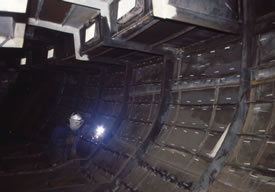
Speaking as a fairly lazy person, who prefers to paint boats with a number ten sable and watercolours, I nevertheless felt - and still feel - that the task of painting one with stinking epoxy and a 3 inch hog-hair brush is a small price to pay for the security of having 5mm of steel between little old me and the two mile drop to the ocean floor. Steel it had to be, for all its drawbacks. Nothing else is as strong, and so nothing else would fit the bill.
However, as the author says, “The idea of building a boat from scratch was never seriously entertained; we are sailors first and foremost and saw this boat building lark as nothing more than a means to an end.” They therefore started looking around for somebody else’s half-built cast-off.
“Let me know, Dick, if you come across any dirt-cheap steel hulls,” I said - and two days later, into my lap Dick dropped a copy of Free Ads. There, in the usual very small print but ringed enthusiastically in red, were the following words:
Absolutely fantastic opportunity for yacht. 50ft. steel hull and deck. Excellent construction. Must sell. Bargain at £10,000 ono.
A 50ft. steel hull and deck for only £10,000! There had to be a catch. Was it rusted beyond all hope? Was it shoddily built? Was the design completely idiotic? When we went to visit the vendor he immediately talked the price down to £7,000. There must be a catch! Maybe the boat did not even exist; perhaps it was all an elaborate con.
There was a catch, of sorts, but it had nothing to do with the state or seaworthiness of the vessel. ... It was, however, quite some time before we could discover these things for ourselves. Indeed, more than a year passed before we got the chance to scrutinise the welds with our own eyes and throughout this time we were able to study her lines only from the paper plans, for this bargain boat lay in a small industrial park at the other end of the world, in Cape Town. That was the catch.
Undaunted, the couple gathered up their belongings, their two small children, and their new baby and stepped aboard a ship bound for South Africa. There followed two years of welding, grinding, blasting, painting, and uphill struggle as they learnt, the hard way, about DIY construction. During this time Nick and Jill Schinas both kept diaries - he, of the technical details involved in building hatches, opening ports, stainless steel water tanks, etc, etc, and she, of the family’s day to day life. By now the boat had been moved from her earlier, insalubrious quarters to a farm in the Cape mountains. Thus, the boat builders were able to live right alongside their project, in a small caravan.
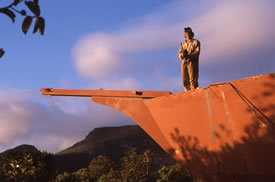
Although they were happy with the design of the hull, Jill and Nick did not like the deck-layout of their new boat, and so the first thing they set out to do was change everything. Hatchways were filled and new ones cut; the bowsprit was lopped off; the wheelhouse also went, and then the couple set about designing and building a cockpit to take its place. It was during the course of these modifications that they made a terrible discovery: pretty though they might be, the welds which joined the hull plates were not sound. Every single one of the welds which fastened together the plates was faulty!
The enormity of this discovery was almost too much to bear. If the welds holding the bulwark together failed when it hit the grass, how would the hull fare when it hit a rock? A couple of years previously we had inspected the remains of a friend’s steel yacht which had been carried ashore onto a boulder-strewn coast. The plating of this yacht had been somewhat dented, but nowhere was it holed. However, one large plate, which formed the turn of the bilge amidships, had been knocked right out of the boat. It lay beneath her on the rocks. This plate had parted company with the rest because the welding was not up to scratch. “Mollymawk has to be stronger than that,” we told each other. “Her welds must be as strong as ever welds could be.”
“The only cure is to grind out the existing weld and bevel the edges of the plate,” said Nick. “Then we’ll have to re-do the whole thing; three runs on the outside and perhaps another on the inside, too, just to be sure.”
“My God! Is that the only way?” If the thought of all that welding was daunting, the idea of grinding out every seam was absolutely devastating. But what else could we do? “We might as well have built this boat from scratch,” I said.
Well we might, as it turned out. The work of cutting out steel plates and assembling them from the ground up surely cannot be more time consuming and arduous than was the labour of grinding out every inch of welding and re-building the entire boat. Heed this, if you are thinking of buying a steel boat: when you take upon yourself somebody else’s half finished project, you take on all the in-built, hidden flaws. Come to that, a finished product could just as easily be faulty; it could have been sailing about, riddled with worm holes, for years, and no one would be any the wiser until it hit the rocks. One more good reason for DIY! When you build it yourself, then you know exactly what you’ve got - and hopefully you’ll get it right.
Grinding out all of the old welds and rebuilding the boat added many months to the project. It also added many lessons - and, naturally - these are all contained in Jill’s book.
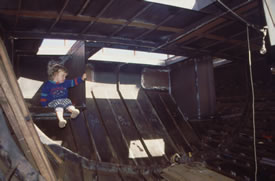
The tone of the tome is light-hearted but, nevertheless, How NOT to Build a Boat contains sufficient advice, information, design tips, and technical know-how to be of real, practical use to a DIY boat builder. My aim was that it should also be “a jolly good read”; the facts are presented in a lively, entertaining manner and the book is designed to interest not only the builder-to-be but also his wife and anybody else who likes a good yarn. To this end, the manuscript has been tested on my very non-technically minded daughter. Any sections or sentences which flowed over her head were re-written.
Specifically, How NOT to build a boat contains information and advice about
- Design seaworthiness, including an explanation of different keel configurations.
- Cockpit design.
- Use of the cutting torch.
- Advice about welding.
- Construction of such things as opening ports, watertight bulkheads, cockpit drains, hatches, the rubbing strake, and the pulpit.
- Different types of insulation and their merits.
- Ballasting.
- In-hull diesel tanks and stainless-steel water tanks.
- In-keel engine cooling system.
- Sandblasting.
- Painting, with a discussion of the different schemes available.
- DIY antifouling.
- Design of the rig and the sail plan.
- The design and construction of steel masts.
- Design and construction of spreaders and chainplates.
- DIY rigging terminals.
- An unusual steering system.
- Shipboard electrics.
- Making your own blocks.
- An emergency steering system.
- Self-steering, with a discussion of different wind-vane systems.
- Toilet and holding tank installation.
- Lexan v Perspex.
- The engine exhaust system.
- Welding whilst at anchor.
- Design for the perfect galley.
We left for South Africa with a “toy” welder - a gift from my father. Although it was capable of producing perfectly good welds this little machine very soon showed itself to be inadequate for the job of building a boat. It was only air-cooled and so it quickly became very hot. After ten minutes of welding in ambient temperatures of over 80°F (27°C) it would cut out. On making this discovery Nick promptly invested in a bigger, more rugged, oil-cooled welding machine, but even this was regarded by the professionals who later encountered it as no more than a toy - and it is worth noting that this oil-cooled machine would have served the purpose little better than its predecessor had it not been waterproof.
There was nothing on the box to say that the new welder was waterproof, and nor would Nick or I have guessed that it might be. It was Innocent who told us to stick it in a bath of water. Innocent was a professional welder, but not a particularly brilliant one. He was innocent by name and by nature also, but he was not very bright and I, personally, would not have trusted him to know how to turn on an electric kettle. As for this latest idea - stick an electric transformer, pulsing with enough current to light up the whole farm, into a bath of water - what a ridiculous notion! But hardly had I turned my back when Nick did the deed. When I returned to the paddock that afternoon I found the welding machine sitting up to its neck in a tub of water. Only its face was showing, with the all-important electric terminals.
One tub of water alone would not have been enough to keep the welder cool. That tub of water, intimately embracing the machine, would soon have become hot enough to make tea. The trick was to keep the bath fed with a continuous supply of cooling water, and to this end the tap was turned on and the hose was left dangling in the bath. The welder stayed relatively cool and nobody was electrocuted, but I should like to make it absolutely clear that I am not recommending that anybody else put their welder under water. I am making no recommendations at all; I am merely telling what went on.
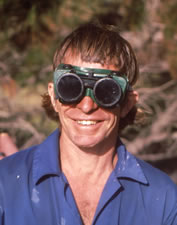
Cutting metal with a torch is great fun, and very easy - or so Nick tells me. It certainly looks that way, and it is one aspect of steel boat building that I would certainly have liked to try, had I not been left holding the baby. ... Apart from anything else, you get to wear a really natty pair of goggles which make the wearer look like some sort of cross between Biggles and a Soviet spy.
For the safe and happy operation of your new cutting toy, please observe the following safety tips:
- The surface below the work - and the operators tootsies, too - must be protected from the molten metal which drips from beneath the torch. In the course of removing Mollymawk’s bowsprit Nick killed an olive tree which was innocently minding its own business below. He also started several small grass fires.
- The plate itself gets so hot that it is inclined to buckle, and anything thinner than 3mm is better cut with a grinder.
The plate gets quite hot enough to fry eggs, gets hot all over - not just at the place where it is being cut - and remains hurtfully hot for several minutes after the cut has become innocently dull in colour once again. I mention this for the benefit of any adults who may be reading this book; children under the age of ten seem to be eminently sensible about this sort of thing - our three and their friends all kept their distance, and none of them was ever hurt during our boat building endeavour - but several adults forgot the rules and burnt their fingers fingering freshly cut plates.- Do not use the torch to cut old, used fuel tanks. For that matter, do not use it in the immediate vicinity of anything containing fertiliser or other explosive materials.
- Finally, do not go away thinking that this marvellous toy can be used to cut out all the bits of steel from which to build your boat. In the hands of an inexperienced operator the torch leaves ragged edges wherever it goes. Generally speaking, if you want to be able to weld the plate after it has been cut by this method the edges will still need to be tidied up with the horrid, hateful grinder.
The edges which the torch leaves behind are particularly ragged if the metal it is cutting is rusty. Rust is ferrous oxide- the very thing that one is seeking to create, on the instant, by adding oxygen to the hot metal! Any rusted metal immediately adjoining the cutting line will therefore automatically be dissolved, even before the oxygen is added to the recipe.All this having been said, the torch is still the best thing around for cutting thick pieces of metal plate. Cutting through 5mm steel plate with a grinder is a long, slow, painfully noisy process and an expensive one; the grinding disks disappear fast. Moreover, one’s ability to get a good clean edge improves with practice. Nick once came back from a trip to town in a very melancholy state. “What’s happened?” I demanded to know.
“I saw a man cutting with a torch,” he answered. “I guess I’m just no good at it.”
“What do you mean? You can cut with the torch!”
“I can cut - but I can’t get clean edges. This fellow was cutting through a plate fully nine inches thick, and getting an edge clean enough to eat off.”One final tip, from the tyro feeling his way through the darkness: buy long hoses. The gas bottles are very heavy and you do not want to have to keep lugging them around. Certainly, you do not want to have to carry them up the ladder and get them on deck.
Although they were new to boat building, Nick and Jill Schinas already had plenty of practical experience of ocean cruising - quite a bit more experience than many professional designers and boat builders have - so that even though at times they may have struggled to achieve their aim, they always knew exactly what was wanted. Many DIY boat builders lack this experience and so make unnecessary mistakes. During their adventure Jill and Nick met a number of other brave souls who were heading the same way but whose boats contained all sorts of silly in-built errors. And Jill has not hesitated to expose these mistakes, for the greater good of mankind.
For some men boat-building is like fishing, or gardening, or making model railways. They dream of the day when their boat will be built, and some of them talk vaguely of cruising, but their real pleasure is in creating. These are the men who take 15 years to build a boat and then sell it, very often without even bothering to launch. (“The wife wasn’t really interested.”)
The finest example of this particular breed of builder was Frank. At the age of thirty Frank had started building a Nicholson 36 in the corner of an aircraft hangar. By the time we met him the hangar was long abandoned and the roof was falling in, but the Nicholson still stood in the corner and every weekend, and at odd moments during the week, her builder arrived for work. The yacht was beautifully constructed of epoxy coated planks and she had a teak-laid deck. Her engine was in, her mast and sails were at the ready - but somehow Frank could not get the galley to go right. He had taken it out and rebuilt it three times now, he told us. And then there was the question of the bunks. When he started building the boat it had been with the idea of doing some ocean racing, and so she had been furnished in a manner suitable for the accommodation of six gung-ho lads.
“But now... well, it’s a bit different now,” he said. “A man of seventy-six needs a little bit of comfort. I might have to do the whole interior all over again.”
All things considered, God did well to find a man like Noah.
The decision to blast was made early on and was swiftly followed by the realisation that we could not afford to have somebody do the job for us.
“Well, now,” Nick said to himself, “These sandblasting blokes are no bigger than me, and they’re no cleverer than me. If I can learn to weld, I can surely learn to sandblast.”Everybody wanted to have a go - but nobody wanted to have a second shot at playing sandman. It is a job which might suit a Tuareg, I suppose, although I doubt whether even a Saharan sandstorm could be as vicious as the one kicked up by the sandblasting kit. After a session of blasting Nick’s socks would be full of sand, and he once frosted a pair of glasses which were inside their metal case, inside the back pocket of his jeans, inside his boiler suit. Without the air-fed helmet it would be impossible for the operator to breathe, let alone see or think, and even with it Nick still got sand in his hair and in his ears.
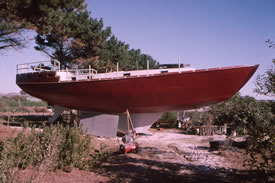
Meanwhile, back on the farm... As the boat slowly took shape and was transformed from a hulk to a shapely hull, the Schinas children also grew. The older ones learnt about cows and ostriches, and also learnt about chipping welding slag. The baby became a toddler and learnt to climb out of her playpen, set up in the shadow of the boat. In some ways the family’s situation was idyllic, but Jill and Nick were nevertheless desperate to be back on the water. After two years they simply couldn’t take any more. The boat was watertight. That she was still bereft of any furnishings mattered not. The time had come to launch her.
“Up!” shouted Mike to the crane driver, reinforcing the command with a gesture. “Out,” he signalled to the lorry.
Up went the boat - up six feet (two metres) - and out went the lorry - out just 12 inches (30cms.); then it stopped.
Oh, why did the lorry stop? We shall never know. And why did the crane driver, suddenly and without warning let his load fall again? All 20 tons of our pride and joy descended, in a split second, to land on one jagged spike - the sawn off tip of one of the cradle arms.
“Up! Up!” we all screamed, and he did, but it was too late; the damage was done.
We all rushed forward to take a look. Just under the turn of the bilge, just for’ard of the bump where the cradle had been attached, there was a scar about three inches (8 cm) long, and at the deepest end of the scar there was what seemed to be a tiny fracture. ”You’ve made a hole!” I howled at Mike.
With the boat, eventually, introduced to her intended environment the Schinas family promptly moved aboard. “That was the biggest mistake of our lives,” says Jill. “Once we were all living aboard it was virtually impossible for Nick to get any work done.”
One man and one woman, working together, can achieve a tremendous amount. One man working alone can do a lot, as Nick had shown. But one man, with one woman and three young children under his feet is like a hobbled sheep. If only we had not moved aboard then the unattainable might have been attained. If only ... But, as it was, almost a year slipped by before we were even ready for our first trial sail.
The trial sail was planned and promised and advertised over a period of weeks. “In a couple of weeks,” Nick told us all, “we’ll take her out.” Then, a fortnight later, it was, “Maybe in a few days time.” After a few days we arrived at, “Maybe tomorrow,” and a week or so after that it was, “Tomorrow, we’ll definitely go out.” By the time tomorrow arrived we had a sizeable audience, and by the time we were actually ready to go out it was late in the afternoon and the north wind was pumping across the bay. Prudence suggested that we wait until the following morning - but Nick has never met Prudence. “We’ll go anyway,” he said.
Off we went, with a crew of trippers cluttering the deck and the occupants of the yacht club bar assembled on the balcony. Was it excitement which stirred up my innards, or just stage fright? Up with the sails and off with the engine - and there we were, tearing across the bay. Our faces lit with contented grins - but mine soon clouded with a fresh worry.
“She’s got too much sail on her,” I said. The lee rail was awash. “We should drop the mizzen, don’t you think, Nick?”
“She’s fine,” said he. “Are you ready to go about? We’ll put in a tack just before the dockyard wall.”
Down went the helm, to the cry, “Lee-oh,” and Mollymawk spun up into the wind.
I hauled the genoa through the wind. “Phew! These sheets are heavy! There must be some friction somewhere, Nick.”
But Nick was not listening. He had leapt from his position behind the wheel and was running to the foredeck.
“Nick? What...?”
Not a great one for explanations, our Nick. He dodged round the trippers, who were still chattering merrily, reached the bow and with a wild kick sent the anchor plunging overboard.
“Nick! Whatever...?”
“Steering’s broken,” he said curtly, as he dithered on the bow, one eye on the dockyard wall. Later he explained all: as he put the helm down the pressure had gone off the wheel and it had spun freely in his hands.
The plough anchor did not hold - and this was no time to be thinking of taking a look below or making repairs. The outer wall of the dockyard was scarcely five boat’s lengths to leeward, and it was hard and knobbly; a sloping wall, built of rock bastions piled up in disarray. Nick ran to get The Insurance Policy (a 50kg Bruce anchor) from the stern locker. ... Alerted by our evident distress the trippers ran up and down the deck like headless chickens and one of the kids asked me, “What will we do if we hit the wall?”
“Sink,” I answered vaguely as I dived below to grab the telephone.
Yes, help was what we needed and since the VHF was not yet installed the mobile phone was our best link with the shore - but who should I call? The lifeboat station was but 500 yards away, adjacent to the yacht club, but the lifeboat men themselves were certainly not there - and, anyway, I did not know their number. ... The yacht club, then; I would phone the yacht club. Somebody gave me the number and I tapped it in. “Oh, please let somebody answer it. Please don’t let me get the answerphone.”
The voice of one of the barmaids came wafting into my ear and, forcing myself to be cool and calm, I explained our predicament.
“Oh, we thought you seemed to be having a bit of difficulty,” said the barmaid cheerily, and then she proceeded to witter away. My calmness was evidently a mistake.
“We need some help!” I yelped. “Send someone out with the launch - and please be quick!”
One minute later, Nick lobbed the Bruce over the bow. Thirty seconds after that - and two boat-lengths from the grim wall - the boat stopped drifting as the hook bit and held. And in the same moment, a grey patrol boat appeared from the dockyard and came storming towards us. The bimbo behind the bar may have been none the wiser but her customers knew well that the club launch, with its puny outboard, could never have towed us into a force six. They had called out the navy.
The powerful launch came alongside ours and we made fast. How embarrassed we felt, to be returning to our berth in this ignominious way! Our audience was by now assembled on the jetty, “ready to help with your lines,” as they explained, and it was with red faces that we handed them over.
“You didn’t try anchoring near the dockyard, did you?” one asked. “Nothing sets there; whenever they dredge the entrance, that’s where they dump the silt.”
We explained that anchoring had not been our primary intention.
“Now, if you were South Africans,” said the club’s censorious, child-hating, most senior member, “and if your boat was South African, you wouldn’t have been allowed to go outside the bay without some kind of emergency self-steering system.”
“They weren’t outside the bay!” somebody chipped in.
“A wise sailor prepares himself for the worst,” said the sage.
“Never mind,” commented another. “That’s what a trial sail is for; to see what breaks.”
A year after launching, the Schinas family cast off their mooring lines and set off to resume their sailing adventures.
Ready or not, we were leaving South Africa - and, of course, we were not ready. The rig was complete - that was what mattered most, to the skipper - the steering had been tried and tested, the engine worked... and that was about all. We had two masts, and they were now properly stayed. The sails had been cut to size and we had had a mizzen made. The halyards and sheets were rigged, and the winches were fitted - but there were no cleats anywhere on the boat. The mooring lines which had held us for the past year had been passed through the scuppers and doubled back onto themselves, and the halyards were fastened likewise. The sheets, too, would have to be made up in this way.
Below decks, we were no longer sleeping on the fuel tanks and cooking on a camping stove. A visit from Nick’s brother and his family had given me the necessary leverage to force the builder to forsake his deck work, for a couple of days, and put down some floorboards in the saloon. Later, I had managed to nag him into constructing a king size double bed in the aft cabin - just the one bed where we all could crash out - and my father-in-law, when he came to stay (in a hotel, of course) had bought us a cooker. This was all that we had below decks aboard Mollymawk when we upped and offed.
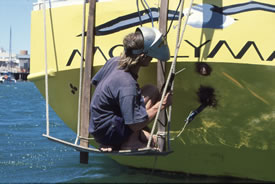
For the next two years the family lived aboard and cruised in their unfinished yacht. Jill’s description of these travels provides a clear portrait of the cruising life, but her account also serves as a backdrop for the continuing saga of the boat-building adventure. Besides describing the perils of welding from the rubber dinghy and the difficulty of building a dinette while the kids are clambering about the cabin, she also reconsiders each element of Mollymawk’s design and construction. In effect, the slow and devious passage from South Africa to Spain was a gigantic shake-down cruise.
In the two hours that it had taken us to roll down the coast the wind had risen considerably, and as soon as we put Mollymawk across the seas she was reduced to a piece of flotsam. No, that is unfair; she was not actually flotsam - the mizzen and the reefed genoa still dragged the boat along, across the waves, at about eight knots. But when the gigantic, bullying swells picked up the boat and pushed her sideways, then Molly behaved like a frightened horse. The mizzen being somewhat larger than the patch of sail which we flew at the bow, the boat was less than well-balanced. Consequently she kept trying to head up into the wind and waves. It was all that I could do to hold her on course, and the strain on the rudder must have been tremendous.
Given that the wind was now blowing absolute stink we should not actually have been riding along under furled genoa and the mizzen. We should have dowsed the genoa and rigged the storm jib, and we should have reefed or taken down the mizzen. Now it was too late. If we turned into the wind now, the sails would certainly be damaged, and as the sails flogged the rig would also take more of a shaking than might be good for it. So it was that Mollymawk went hurtling onwards, like a white dove torn from a tree and bowled helplessly along on the tempest.The picture of this mad dash is printed very vividly in my mind. We were staggering along, battered by the waves and brutally hammered by the storm force wind when, all of a sudden, we were at the centre of a company of heavisides dolphins. If dolphins could shout for joy, those heavisides would have been shouting. Since they could not, they leapt instead. Heavisides very seldom leap, but these ones had a routine. They came surging down towards us, inside the glassy wave, in tight ranks of four, five, or six. They swept on under our starboard quarter; they emerged, moments later, on the port bow, and there they leapt for joy. No doubt a scientist would accuse me of anthropomorphism, but there is really no room for doubt: these cetaceans were having a whale of a time (sorry about that) and they were jumping for joy. Like children playing in the park, they kept on repeating their performance just for the fun of it.
I felt my anxieties fade. It was impossible not to be infected by the gay mood of these, our companions. That, at any rate, was the way I felt. The children did not share my enthusiasm - but, then again, the children steadfastly refused even to glance at the dolphins. They were huddled together on the leeward side of the cockpit, shivering. Now and then, I would even hear a sob escape from the little knot of colourful oilskins, but on no account would any of the three raise their heads or respond to my conversation. Although most of the waves were content to pass under the boat, and shove us around, a great many preferred to take a short cut over the top. In taking this route the waves invariably dumped about a ton of icy cold water over the cockpit and the crew - but, in spite of this, the kids still resolutely refused to go below on their own. And there was certainly no possibility that either one of their parents might be free to accompany them; Nick was obliged to give his entire attention to the navigation, and I had my hands full in managing the boat. It was evident that the sooner we got this sorry little crew to safe harbour, the better.
The penultimate chapter of How NOT to Build a Boat is called Grounds For Divorce. After two years of living in a half-built boat the author could take no more. And neither could the kids.
The lack of lockers and want of anywhere to sit were, for me at any rate, a far greater hardship than the want of a fully functioning self-steering, or the leaking hatches. My unhappiness with our living conditions was such that by now I was becoming almost suicidally depressed; I was absolutely desperate - more desperate than I could ever say - for the boat to be made habitable.
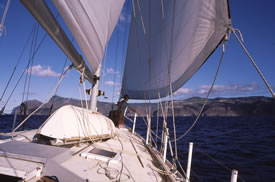
How NOT to Build a Boat is copiously illustrated - and it will be ready for publication just as soon as all of the pictures and diagrams are finished. Whether Mollymawk will ever be finished is another matter, but despite the fact that the boat is still a work in progress the Schinas family have now set off on another mad adventure.
If you are planning to build a boat, please read this book before you start. It could save you time, money, and your marriage. Likewise, if you are interested in a light-hearted tale of determination, folly, and extremely alternative living, this is essential reading.
How NOT to Build a Boat is now available!
For more information, and instructions on how to order, please visit the Yacht Mollymawk website.